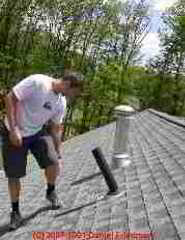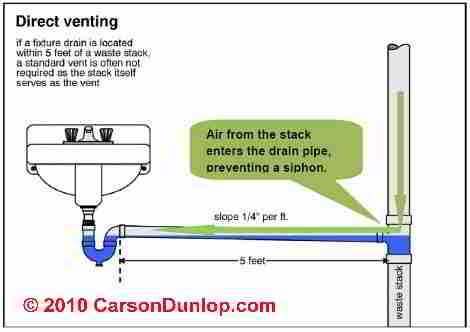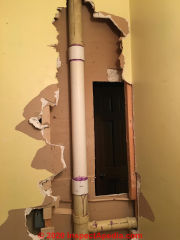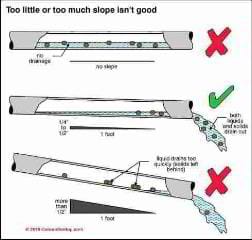 Plumbing Vent Noise Diagnosis
Plumbing Vent Noise Diagnosis
Building Noises traced to plumbing drain, waste, or vent piping problems: causes & cures
- POST a QUESTION or COMMENT about diagnosing and fixing plumbing vent and drain noises
Diagnostic guide to plumbing drain noises:
This plumbing drain and vent noise article explains proper plumbing vent piping and how errors cause trap siphonage, odors, and plumbing noises such as gurgling or a glub-glub-glub noise at plumbing drains or fixtures.
Building noises such as gurgling drains and some building odors (sewer gas, methane, toilet smells) are often traced to defects in the plumbing vent system. Here we explain the causes and cures of these problems.
InspectAPedia tolerates no conflicts of interest. We have no relationship with advertisers, products, or services discussed at this website.
- Daniel Friedman, Publisher/Editor/Author - See WHO ARE WE?
Plumbing Vent Noises – Why Basins Sometimes Talk Back
 Alan Carson, Carson Dunlop & Associates
Alan Carson, Carson Dunlop & Associates
Illustration provided courtesy of Carson Dunlop Associates, a Toronto home inspection, education & report writing tool company [ carsondunlop.com ].
[Click to enlarge any image]
Article Contents
- PLUMBING VENT NOISE - CONTENTS: Plumbing Vent Piping Noise Sources, Causes, Cures - what causes various kinds of noises traced to plumbing system vent piping?
Catalog of sources of building noises or plumbing system noises traced to problems with the plumbing vent system- DEFINITION of PLUMBING VENT - what is it?
- FUNCTIONS of PLUMBING VENTS: What is a plumbing vent, how do plumbing vents work & why are they needed
- WHY DRAIN PIPES MAKE NOISE or gurgling or blub blub blub glub glub glub sounds in buildings - What causes those gurgling sounds at sink drains, tub drains, shower drains?
- AVOID DRAIN TRAP SIPHONING we need one of these solutions
Definitions: Plumbing Vent Terminology
This article and the illustrations were prepared by Carson Dunlop Associates, with edits and additions by InspectAPedia.com .
This material appears in the ASHI@HOME Training System and are used here with permission from the original authors.
The illustration at left, courtesy of Carson Dunlop Associates, shows the names of some of the pipes in a venting system.Plumbing drain or sewer gas odors
Watch out: If you smell sewer gases in your building conditions could be dangerous (risking a methane gas explosion) or unsanitary.
See REMEDIES for SEWER ODORS, PLUMBING and
also see ODORS GASES SMELLS, DIAGNOSIS & CURE.
Plumbing drain or fixture noises: Other advice about controlling plumbing noises in buildings is
at PLUMBING DRAIN NOISE DIAGNOSIS and
at SOUND CONTROL for PLUMBING.
You run water into the basin and everything seems fine, until the last bit of water leaves the fixture. The loud, slightly rude, gurgling noise draws puzzled looks from your client and the agent. What's going on? Does it matter?
The problem is in the plumbing venting system and the risk is not noise, but sewer gases entering the home because the trap has no water. Most home inspectors understand this problem to some extent, but it's hard to visualize what's happening. In this article we'll review the functions of vents, touch on the terminology, and then look at why things gurgle.
The Functions of Plumbing Vents: how do plumbing vents work & why are they needed
 The venting system equalizes the air pressure throughout the waste piping system. Why does this matter? Let's look at four functions of vents.
The venting system equalizes the air pressure throughout the waste piping system. Why does this matter? Let's look at four functions of vents.
1. The waste won't flow properly if it can't push the air in the pipe ahead of the waste out of the way. Plumbing vents allow air out of the waste pipes.
2. The waste won't flow well if it's held back by low air pressure or a vacuum in the pipe behind it. Vents allow air into the waste pipes.
3. We don't want the water to be siphoned out of the trap every time a fixture is used. It's the water sitting in a plumbing trap that stops sewer gases getting into the home. Vents allow air in to prevent a siphon.
4. Plumbing vents allow sewer odors to escape from the house, venting safely above the roof. Without venting, the sewer gases seep through the water in the trap and enter the house. Vents help sewer gases escape outdoors.
Gurgling Sounds and Sewer Gases at Sink Drains, Showers, Tubs
Plumbing drains work by gravity. Gravity pulls the water out of the fixture and down the drain pipe. Gravity wants to leave some water in the trap because it's a low spot. That's all good.
But when the sink basin is empty, how do we split that solid slug of water flowing through the pipe, so that some stays in the trap and the rest flows down the drain?
The venting system allows air to get between the water going down the drain and the water staying in the trap. The illustration below shows this nicely.

The maximum distance from the sink basin trap to a vent is usually about 5 feet. What’s magic about 5 feet? Here’s a clue: The drain slope is about ¼ inch per foot.The smallest drain line is 1 ¼ inch diameter. There are five ¼ inches in a 1 ¼ inch pipe.
As the last bit of water flows, we don’t want the lower end of the drain pipe to be flooded.
That creates a vacuum that results in siphoning. If the drain is 5 ft. or less, the low end of the drain is not flooded, and air can get in.
Our sketch (above left) illustrating the basics of plumbing traps is also provided courtesy of Carson Dunlop and appears
in DRAIN WASTE VENT PLUMBING [PDF],
a section of Carson Dunlop's Home Study Course for Home Inspectors.
Without an effective plumbing drain vent, a vacuum forms in the pipe between the water going down the drain and the water that needs to stay in the trap. A siphon is created and the atmospheric air pressure pushes the water out of the trap to satisfy the vacuum.
This allows sewer odors to back up into the house. The gurgling sound is air forcing its way through the water in the trap. (See illustration below.)
If the drain pipe (trap arm) is longer than 5 feet distance from the vertical plumbing vent stack, or the plumbing drain pipe slope is more than ¼ inch per foot, a 1 ¼ inch diameter pipe will flood.
That’s the same as having no vent. The illustration below shows that air from the stack can’t get into the trap arm, and a siphon results.
As Carson Dunlop Associates sketch (above) shows, the slope for drain piping should be between 1/8 and 1/4 inch per foot for 3 inch or larger diameter pipe, but it should be a minimum of 1/4 inch for smaller pipe such as the sink basin drain in our example above.
The sketch shows what happens if a drain pipe is sloped too little (it doesn't drain and drain pipe clogs develop) or too much (water drains too fast and leaves solids behind, and pipe logs develop).
In larger diameter waste pipes, such as a blackwater line from a toilet or a 6" sewer pipe, a slope that is too low or a slope that is too steep can lead to clogging as solids are left behind in either case.
If we try to apply the 5 foot rule for distance between the sink basin trap and the soil waste stack/vent pipe (at the right in our illustration above), and if we have a slope that's greater than 1/4 inch per foot, we will create a siphon.
That's why the Uniform Plumbing Code (UPC) limits the 5 foot distance in our general (not code specific) illustration above to 2 1/2 feet.
A plumbing trap siphon is created and the atmospheric air pressure pushes the water out of the trap to satisfy the vacuum. This allows sewer odors to back up into the house.
The gurgling sound heard at a plumbing drain is air forcing its way through the water in the trap. (See illustration below.0
If the drain pipe (trap arm) is longer than 5 feet, or the slope is more than ¼ inch, a 1 ¼ inch diameter pipe will flood. That’s the same as having no vent.The illustration at left shows that air from the stack can’t get into the trap arm, and a siphon results.
To Avoid Plumbing Trap Siphonage We Need One of the Following
- A plumbing vent. Our photo (left) shows a gaggle of rickety plumbing vents atop a Buenos Aires apartment building.
- A larger diameter trap arm or
- An air admittance valve or AAV (siphon breaker)* to break the siphon and prevent the trap from being emptied. Siphon breakers are not code approved in all jurisdictions, or may be approved on an "exception" basis.
We can say it another way. The fall of the trap arm should be less than one pipe diameter over the distance between the trap and the vent. Remember, you’ll rarely see this in the field, but it’s important to understand the principle.
When you hear the gurgling, the problem is a health issue and the answer is venting. You may not hear the gurgling if you only run a little water.
Some authorities (e.g. The 2006 Uniform Plumbing Code) add a safety factor and reduce the 5 ft. limit to 2 ½ ft. It’s always good to know the rules in your area.
See AIR ADMITTANCE VALVES AAVs for a definition of AAV and for more details about AAV devices, and also
see PLUMBING VENT CODES, DEFINITIONS, TYPES.
* STUDOR is a good example of an approved air admittance valve. These devices do not include a spring, only a diaphragm. This makes them more mechanically reliable. OATEY also makes an air admittance valves, possibly also spring-loaded auto vent types.
We believe ProVent and the V-200 are spring-loaded siphon breaker valves and are not approved in some code jurisdictions.
The Sealing Disc of the V-200 automatic plumbing vent anti siphon valve [air admittance valve] must be located at least 6" above the top of the trap arm. NOTE: An Angle Mounting of no more than 15 degrees from the Vertical is acceptable.
Location of the V-200 is no way related to the flood level of the fixture that it's venting.
The V-200 functions equally well above or below the flood level of any fixture in the home. - V-200 ABS Auto Trap Vent product description, V-200 anti siphon valve installation instructions [Image] from manufacturer Oakville Stamping & Bending.
See UPC Section 909.0 for plumbing code discussion of the use of air admittance valves in residential buildings. Examples of air admittance valves (AAV s) include models produced by IPS - Studor (Studor Vent), Keeney Mfg. Vanity Installation Kit, Oatey 20 DFU Sure-Vent, IPS Corporation's Redi-Vent, and other suppliers.
Also see PLUMBING VENT CODES, DEFINITIONS, TYPES
A word about ASHI@HOME for home inspectors: You can take any one of the 10 courses and receive ASHI CE Credits. The Plumbing course for example, gives you 36 CE Credits. For more information contact Carson Dunlop - more information is below at Technical Reviewers & References. (Scroll down).
The above article is reprinted, with minor edits and amendments, with permission from Carson Dunlop Associates.
Also see this example DRAIN WASTE VENT PLUMBING excerpt [PDF] from the ASHI@HOME education program, courtesy of Carson Dunlop appeared in the ASHI Reporter.
...
Reader Comments, Questions & Answers About The Article Above
Below you will find questions and answers previously posted on this page at its page bottom reader comment box.
Reader Q&A - also see RECOMMENDED ARTICLES & FAQs
On 2020-10-04 by Tracy
It's a 3" pipe on a standard shingled rooftop. not real steep. Probably a normal slope on a ranch style house. So we really don't have snow sliding off.
Thanks for your reply. I was thinking about jamming some insulation into the opening or maybe a wood shim to tighten it up. But your saying it's better to allow it to move and free it up?
On 2020-10-04 - by (mod) -
Tracy:
regarding the snapping clicking plumbing vent pipe, see if you can find a place where piping is passing through a too-tight opening in a wall, ceiling, etc. - often giving just a bit of space to allow movement will be enough to cure the trouble.
On 2020-10-04 by (mod) snapping noise at plumbing vent
 Tracy:
Tracy:
It's generally desirable to have plumbing vents that are high enough not to be blocked by snow; also take a look at the vent diameter; if it's too small - say just 1-2" it may also be getting blocked by frozen condensation rising in the vent stack.
A concern suggested by your question is the risk of the vent above the roof being broken off by snow sliding down the roof - as has happened to me. That risk is greater on slippery metal roofs or on very steep slope roofs; if you never have snow sliding off your roof it's not a worry. Else you may need snow guards or a brace.
If I've got your photo "right-way up" and if that horizontal drain at the lower right is in fact a wet drain line from a plumbing fixture it's installed upside down and won't drain properly. If it is ONLY a vent then it's correct.
On 2020-10-04 by Tracy
I live in ND and I am wondering if I should extend my main sewer vent stack on the rooftop. It's about 6 to 8 inches now. Barely sticks out of the snow in the winter if we get dumped on good. I also have a bad odor in the yard in front of the house where it comes off the vent.
My question is how high is safe / good? and can I just glue a collar on the existing stack and glue in a 3 to 4 inch piece on top of the collar?
I had a main sewer vent in my house leaking gas through 5 screw holes made from a previous owner. I cut out the roughly 3 foot section and glued in a new piece with collars. Now the vent pipe clicks and snaps rather loudly when running water. I believe it is because now the vent pipe is sealed and it is slightly moving when venting causing this snapping noise.
It never made this noise before I replaced the holes and sealed the leaks. The closer the water running source to the vent, the more and faster it snaps. It will continue to snap periodically throughout the day even when not using water.
On 2020-08-24 by (mod)
David: a stuck Air Admittance Valve or AAV that doesn't let air into the drain can cause poor drainage, slow drainage, noisy drains. You'll need to take a careful look and listen at the AAV to see if that's what's chattering; it could be the valve.
On 2020-08-24 by David
Does a bad aav make chattering noises and cause drains to stop up? I never heard the chattering before. Every time I plunge the kitchen sink the drains clear and five minutes later they are backing up again. I have been doing this five times a day for a week. All the other drains are working properly.
On 2020-08-08 by lin
I have a two story home with a basement... When a toilet is flushed on the main floor, gurgling is heard in the upstairs bathroom. What causes this and can it be corrected without calling a plumber? Would appreciate help.
On 2018-10-18 - by (mod) -
That's not a cause for water hammer.
Search InsperctApedia for WATER HAMMER to read diagnosis and cure procedures
On 2018-10-16 by Sandra Earwood
Can my water pipes hammer if i have inadequate venting?
i hear water hammering when i turn any faucet on or off and when i flush a toliet.
The hammering is in a wall behind a jetted tub and sort of in the middle of two toliets.
...
Continue reading at PLUMBING VENT REPAIR or select a topic from the closely-related articles below, or see the complete ARTICLE INDEX.
Or see PLUMBING VENT NOISE FAQs - questions & answers about noisy plumbing vents, posted originally at the end of this page.
Or see these
Recommended Articles
- PLUMBING NOISE CHECKLIST
- PLUMBING SYSTEM NOISE DIAGNOSIS & CURE - home
- BANGING HEATING PIPES RADIATORS
- CLOGGED DRAIN DIAGNOSIS & REPAIR
- DRIPPING WATER SOUND Sources
- PLUMBING DRAIN NOISE DIAGNOSIS
- PLUMBING DRAIN NOISE REPAIR
- PLUMBING NOISE TRANSMISSION CONTROL
- PLUMBING SUPPLY PIPE NOISE
- PLUMBING VENT CODES, DEFINITIONS, TYPES
- PLUMBING VENT DEFECTS & NOISES
- PLUMBING VENT NOISE
- PLUMBING VENT ODORS
- PLUMBING VENT REPAIR
- SOUND CONTROL for PLUMBING
- WASHING MACHINE NOISE CAUSE & CURE
- WATER HAMMER NOISE DIAGNOSE & CURE
- WATER HEATER NOISE DIAGNOSIS, CURE
- WATER PUMP NOISE DIAGNOSIS
- WATER SUPPLY PIPE WHISTLE NOISE
- WATER TANK NOISE DIAGNOSIS
- SOUND CONTROL in BUILDINGS
Suggested citation for this web page
PLUMBING VENT NOISE at InspectApedia.com - online encyclopedia of building & environmental inspection, testing, diagnosis, repair, & problem prevention advice.
Or see this
INDEX to RELATED ARTICLES: ARTICLE I NDEX to BUILDING NOISE DIAGNOSIS
Or use the SEARCH BOX found below to Ask a Question or Search InspectApedia
Or see
INDEX to RELATED ARTICLES: ARTICLE I NDEX to PLUMBING SYSTEMS
Or use the SEARCH BOX found below to Ask a Question or Search InspectApedia
Ask a Question or Search InspectApedia
Questions & answers or comments about diagnosing and fixing plumbing vent and drain noises
Try the search box just below, or if you prefer, post a question or comment in the Comments box below and we will respond promptly.
Search the InspectApedia website
Note: appearance of your Comment below may be delayed: if your comment contains an image, photograph, web link, or text that looks to the software as if it might be a web link, your posting will appear after it has been approved by a moderator. Apologies for the delay.
Only one image can be added per comment but you can post as many comments, and therefore images, as you like.
You will not receive a notification when a response to your question has been posted.
Please bookmark this page to make it easy for you to check back for our response.
IF above you see "Comment Form is loading comments..." then COMMENT BOX - countable.ca / bawkbox.com IS NOT WORKING.
In any case you are welcome to send an email directly to us at InspectApedia.com at editor@inspectApedia.com
We'll reply to you directly. Please help us help you by noting, in your email, the URL of the InspectApedia page where you wanted to comment.
Citations & References
In addition to any citations in the article above, a full list is available on request.
- DEVELOPMENTS in NOISE CONTROL [PDF] NRCC, National Research Council, Canada, suggestions for noise control, sound transmission through block walls, plumbing noise control, noise leaks, and sound control advice. Web search 01/17/2011, original source: www.nrc-cnrc.gc.ca/eng/ibp/irc/bsi/90-noise-control.html
- Oakville Stamping & Bending, 2200 Speers Rd.,
Oakville, Ontario
Canada L6L 2X8
(905) 827-0320 or
(905) 827-6375 FAX - Email: osb@osb.ca produces and supplies the V-200 automatic plumbing vent.
We believe ProVent and the V-200 are spring-loaded siphon breaker valves and are not approved in some code jurisdictions. The Sealing Disc of the V-200 automatic plumbing vent anti siphon valve must be located at least 6" above the top of the trap arm. NOTE: An Angle Mounting of no more than 15 degrees from the Vertical is acceptable. Location of the V-200 is no way related to the flood level of the fixture that it's venting. The V-200 functions equally well above or below the flood level of any fixture in the home. - V-200 ABS Auto Trap Vent product description, V-200 anti siphon valve installation instructions from manufacturer Oakville Stamping & Bending. - Our recommended books about building & mechanical systems design, inspection, problem diagnosis, and repair, and about indoor environment and IAQ testing, diagnosis, and cleanup are at the InspectAPedia Bookstore. Also see our Book Reviews - InspectAPedia.
- In addition to citations & references found in this article, see the research citations given at the end of the related articles found at our suggested
CONTINUE READING or RECOMMENDED ARTICLES.
- Carson, Dunlop & Associates Ltd., 120 Carlton Street Suite 407, Toronto ON M5A 4K2. Tel: (416) 964-9415 1-800-268-7070 Email: info@carsondunlop.com. Alan Carson is a past president of ASHI, the American Society of Home Inspectors.
Thanks to Alan Carson and Bob Dunlop, for permission for InspectAPedia to use text excerpts from The HOME REFERENCE BOOK - the Encyclopedia of Homes and to use illustrations from The ILLUSTRATED HOME .
Carson Dunlop Associates provides extensive home inspection education and report writing material. In gratitude we provide links to tsome Carson Dunlop Associates products and services.


